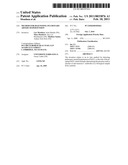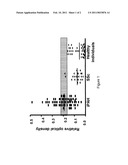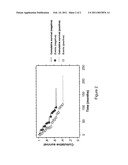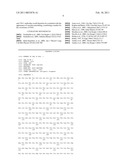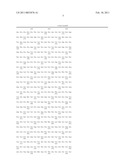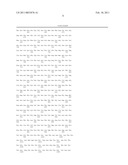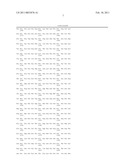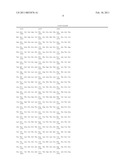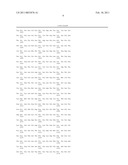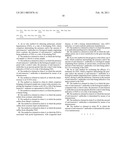Patent application title: METHOD FOR DIAGNOSING PULMONARY ARTERY HYPERTENSION
Inventors:
Luc Mouthon (Saint Mande, FR)
Marc Humbert (Issy Les Moulineaux, FR)
Mathieu Tamby (Aulnay Sous Bois, FR)
Assignees:
UNIVERSITE PARIS-SUD 11
IPC8 Class: AG01N3353FI
USPC Class:
435 792
Class name: Involving antigen-antibody binding, specific binding protein assay or specific ligand-receptor binding assay assay in which an enzyme present is a label heterogeneous or solid phase assay system (e.g., elisa, etc.)
Publication date: 2011-02-10
Patent application number: 20110033876
Claims:
1. An in vitro method for detecting pulmonary arterial hypertension (PAH),
or a risk of developing PAH, which comprises determining the presence
and/or the amount of anti-tenascin C antibodies in a biological sample
originating from a patient, the presence of anti-tenascin C antibodies
being indicative of PAH or a risk of developing PAH.
2. The method as claimed in claim 1, in which the biological sample is a blood or serum sample.
3. The method as claimed in claim 1, in which the presence of anti-tenascin C antibodies in the biological sample is compared with a control value, the presence of anti-tenascin C antibodies in an amount greater than the control value being indicative of PAH or of a risk of developing PAH.
4. The method as claimed in claim 1, in which the amount of anti-tenascin C antibodies is determined by means of an immunoassay.
5. The method as claimed in claim 4, in which the immunoassay is an ELISA assay.
6. The method as claimed in claim 4, which comprises bringing a biological sample into contact with a protein comprising the fragment of amino acids 181 to 290 of the human tenascin C sequence as represented in SEQ ID No. 1.
7. The method as claimed in claim 1, in which the patient is a human being.
8. The method as claimed in claim 1, in which the patient suffers from systemic scleroderma.
9. The method as claimed in claim 1, in which the patient suffers from Sharp's syndrome.
10. The method as claimed in claim 1, in which the patient suffers from systemic lupus erythematosus.
11. The method as claimed in claim 1, in which the patient suffers from idiopathic PAH.
12. The method as claimed in claim 1, in which the PAH is associated with portal hypertension, with congenital heart disease, or with a human immunodeficiency virus (HIV) infection, or is post-embolic pulmonary hypertension.
13. The method as claimed in claim 1, in which the patient is an individual predisposed to developing PAH.
14. The method as claimed in claim 13, in which the individual carries one or more mutation(s) in the gene encoding BMPRII.
15. An in vitro method for the prognosis or the follow-up of PAH, which comprises determining the presence and/or the amount of anti-tenascin C antibodies in a biological sample originating from a patient, at various times, an increase in the amount of anti-tenascin C antibodies over time being indicative of a worsening of the PAH.
16. An in vitro method for evaluating the efficacy of a treatment for PAH, which comprises determining the presence and/or the amount of anti-tenascin C antibodies in a biological sample originating from a patient, at various times before, during or after the treatment, a decrease in the amount of anti-tenascin C antibodies over time being indicative of an improvement in the PAH.
17. The method as claimed in claim 2, in which the presence of anti-tenascin C antibodies in the biological sample is compared with a control value, the presence of anti-tenascin C antibodies in an amount greater than the control value being indicative of PAH or of a risk of developing PAH.
18. The method as claimed in claim 2, in which the amount of anti-tenascin C antibodies is determined by means of an immunoassay.
19. The method as claimed in claim 3, in which the amount of anti-tenascin C antibodies is determined by means of an immunoassay.
20. The method as claimed in claim 17, in which the amount of anti-tenascin C antibodies is determined by means of an immunoassay.
Description:
[0001]The invention relates to the diagnosing and the follow-up of
pulmonary arterial hypertension.
PRIOR ART
[0002]Pulmonary arterial hypertension (PAH) is a rare pathological condition responsible for the occurrence of right cardiac decompensation which can result in death. PAH is defined by the demonstration, by right catheterization, of an average pulmonary arterial pressure of greater than or equal to 25 mmHg while resting or of greater than of equal to 30 mmHg while exercising, in the absence of elevated pulmonary capillary pressure (Rubin, 1997). The occurrence of PAH is the result of a chronic obstruction of the small pulmonary arteries secondary to the proliferation of endothelial cells, vascular smooth muscle cells and fibroblast (Dorfmuller et al., 2003). In particular, during severe PAH, a layer of myofibroblasts and of extracellular matrix forms which localizes between the endothelium and the internal elastic lamina, called neointima, which is characteristic of this condition. PAH can occur during the progression of pathological conditions with an autoimmune component, namely the connective tissue diseases, in particular systemic scleroderma (Hachulla et al., 2005), Sharp's syndrome and systemic lupus erythematosus. In addition, during idiopathic PAH, autoimmunity stigmata, namely anti-nuclear antibodies or anti-thyroglobulin antibodies, are from time to time found.
[0003]The presence of anti-endothelial cell antibodies (Tamby et al., 2005) and of anti-fibroblast antibodies (Tamby et al., 2006) has been reported during idiopathic PAH or PAH associated with systemic scleroderma. However, the predictive value of these antibodies in terms of the occurrence of PAH has not been studied and the potential role of autoimmune phenomena in idiopathic PAH pathogenicity remains uncertain (Mouthon et al., 2005).
[0004]In most cases, PAH is screened for when the patient presents stage III or IV dyspnea. When the patient is monitored for a chronic disease such as systemic scleroderma, PAH is screened for by annual echocardiography.
[0005]However, a simple and reliable test to screen for PAH is still lacking, and would be invaluable for the earliest possible diagnosis, which would make it possible to rapidly set up therapeutic strategies for improving the condition of the patient and the survival chances for said patient.
SUMMARY OF THE INVENTION
[0006]The invention now provides an in vitro method for detecting PAH, or a risk of developing PAH, which comprises determining the presence and/or the amount of anti-tenascin C (TN-C) antibodies in a biological sample originating from a patient, the presence of anti-TN-C antibodies being indicative of PAH or of a risk of developing PAH.
[0007]Preferably, the presence of anti-tenascin C antibodies in the biological sample is compared with a control value, the presence of anti-tenascin C antibodies in an amount greater than the control value being indicative of PAH or of a risk of developing PAH.
[0008]Another subject of the invention is an in vitro method for the prognosis or follow-up of PAH, which comprises determining the presence and/or the amount of anti-TN-C antibodies in a biological sample originating from a patient, at various times, an increase in the amount of anti-TN-C antibodies over time being indicative of a worsening of the PAH.
[0009]Another subject of the invention is an in vitro method for evaluating the efficacy of a treatment for PAH, which comprises determining the presence and/or the amount of anti-TN-C antibodies in a biological sample originating from a patient, at various times before, during or after the treatment, a decrease in the amount of anti-TN-C antibodies over time being indicative of an improvement in the PAH.
DETAILED DESCRIPTION OF THE INVENTION
[0010]TN-C is expressed inside and around the blood vessels in the fetal lung (Rettig et al., 1994), but it is no longer subsequently expressed in normal adult pulmonary arteries (Jones et al., 1996). Moreover, the loss of signaling via BMPRII, responsible for a lack of regulatory T cells that can predispose to the occurrence of PAH (Nicolls et al., 2005), can also induce the expression of TN-C in vivo and on vascular cells in culture (Ihida-Stansbury et al., 2006). On this basis, the inventors put forward the hypothesis that patients who have PAH could develop an immune response directed against TN-C. Thus, they decided to search for anti-TN-C antibodies in the serum of patients suffering from PAH.
[0011]The inventors were thus able to demonstrate a correlation between the occurrence of PAH and the production of anti-TN-C antibodies. On this basis, they propose an in vitro method for the diagnosis or the prognosis of PAH, or of a risk of developing PAH, which comprises determining the presence and/or the amount of anti-TN-C antibodies in a biological sample originating from a patient. The anti-TN-C antibodies detected are preferably immunoglobulins G (IgGs).
Definitions
[0012]Tenascin C (or TN-C) is an extracellular matrix glycoprotein. It is also known as hexabrachion or cytotactin. A human TN-C sequence is reported in the annex (SEQ ID No. 1).
[0013]The term "biological sample" refers to any biological sample originating from a patient. Examples of samples include biological fluids and tissue biopsies. Preferably, the sample may be blood, serum, saliva, urine or sperm. More preferably, the biological sample is a blood or serum sample.
[0014]The term "patient" refers to any individual capable of being tested. Preferably, it is a human being, but the term includes any other mammal, such as dogs, cats, rodents, cattle, horses, monkeys, etc. The patient can be tested irrespective of the sex or age thereof. The patient may be an individual at risk, may be asymptomatic, or may show early or advanced signs of PAH. For example, the patient may be an individual predisposed to developing PAH, in particular an individual carrying one or more mutations in the gene encoding BMPRII.
[0015]The term "diagnosis" means the identification of the pathological condition or the evaluation of the state of severity of the pathological condition.
[0016]The term "prognosis" means the evaluation of the risk of worsening, and of the consequences thereof.
[0017]The term "control value" refers to a basal value corresponding to the average of the values obtained with the biological sample from healthy individuals, not suffering from PAH or a disease capable of leading to PAH. It may be a statistical reference value.
[0018]In order to evaluate the progression of the pathological condition, it may be useful to test a patient and to verify the effect of a treatment or the progression of the pathological condition by testing the patient again, for example with a gap of several months. In this case, the results of the second test are compared with the results of the first test, and also often with the "control" value.
[0019]An amount of anti-TN-C antibodies "greater than the control value" generally means a statistically significant increase, for example of at least two standards deviations above the mean of the optical densities of the IgG reactivities of all the healthy individuals.
[0020]The "capture antigen" is intended to mean an antigen, preferably attached to a solid phase, which is capable of retaining the anti-TN-C antibody present in a biological sample, by affinity binding. The capture antigen can be labeled.
[0021]The term "labeled" refers both to a direct labeling (by means of enzymes, radioisotopes, fluorochromes, luminescent compounds, etc.) and an indirect labeling (for example by means of antibodies which are themselves directly labeled or using reagents of a labeled "affinity pair", such as, but not exclusively, the labeled avidin-biotin pair, etc.).
Assaying of Antibodies
[0022]The biological sample is preferably a serum sample, diluted to 1/100th, or more, for example to 1/200th or 1/400th.
[0023]Advantageously, the amount of anti-TN-C antibody can be determined by an immunoassay.
[0024]The biological sample can be optionally treated in a prior step, or brought directly into contact with at least one capture antigen.
[0025]The method according to the invention can be carried out according to various formats well known to those skilled in the art: in solid phase or in homogenous phase; in one step or in two steps; in a competition method, by way of nonlimiting examples.
[0026]According to one preferred embodiment, the capture antigen is immobilized on a solid phase. By way of nonlimiting examples of a solid phase, use may be made of microplates, in particular polystyrene microplates, such as those sold by the company Nunc, Denmark. Use may also be made of solid particles or beads, paramagnetic beads, such as those provided by Dynal or Merck-Eurolab (France) (under the trademark Estapor®), or else polystyrene or polypropylene test tubes, etc.
[0027]An immunoassay format for detecting antibodies by competition is also possible. Other immunoassay modes can also be envisioned and are well known to those skilled in the art.
[0028]ELISA assays, radioimmunoassays, or any other detection technique can be used for revealing the presence of the antigen-antibody complexes formed.
[0029]According to one preferred embodiment, the method of the invention comprises bringing a biological sample into contact with a protein comprising the fragment of amino acids 181 to 290 of the human TN-C sequence as represented in SEQ ID No. 1.
[0030]In one particular example, the capture antigen, which can be a protein comprising the fragment of amino acids 181 to 290 of the human TN-C sequence, can be coupled to a glutathione S transferase (GST), before being deposited on a microplate.
[0031]Serum samples to be tested, prediluted to 1/100th, are incubated on the microplate. After washing, labeled anti-human Fc γ antibodies (for example, labeled with an alkaline phosphatase) are added, the complexes being revealed, for example, by addition of a substrate for the phosphatase, the cleavage of which can be detected by reading the absorbance.
Patients Targeted
[0032]The patients targeted are those who may develop PAH.
[0033]This may involve a patient who suffers from a connective tissue disease, such as systemic scleroderma, Sharp's syndrome (which is a mixed connective tissue disease) or systemic lupus erythematosus.
[0034]The patient may also be suffering from idiopathic or familial PAH.
[0035]More generally, any patient suffering from a pulmonary vascular disease can be advantageously subjected to the method for detecting PAH as defined in the invention.
[0036]Moreover, the PAH detected may also be portopulmonary hypertension (i.e. PAH associated with portal hypertension), or be associated with a congenital heart disease, or with a human immunodeficiency virus (HIV) infection, or else be post-embolic pulmonary hypertension, complicating the progression of a chronic obstructive bronchitis or of cyanogenic heart disease.
[0037]Other patients targeted are those exposed to certain appetite-suppressing drugs, such as fenfluramine, the prescription of which can contribute to the occurrence of PAH.
[0038]Other individuals capable of benefiting from this type of test are those carrying a mutation in the gene encoding BMPRII and who, optionally, do not present PAH detectable by echography, so as to screen for individuals who may subsequently develop PAH.
Evaluation of the Efficacy of a Treatment
[0039]Another subject of the invention is an in vitro method for evaluating the efficacy of a treatment for PAH, which comprises determining the presence and/or the amount of anti-TN-C antibodies in a biological sample originating from a patient, at various times before, during or after the treatment, a decrease in the amount of anti-TN-C antibodies over time being indicative of an improvement in the PAH.
[0040]The current conventional treatment for PAH combines symptomatic treatment and a vasodilator treatment. The symptomatic treatment combines anti-coagulants, oxygen therapy and diuretics. The vasodilator treatment is based on the following molecules: calcium channel blockers, epoprostenol (prostacyclin) prescribed intravenously as a continuous infusion, selective or nonselective endothelin receptor inhibitors, in particular bosentan, sytaxentan and ambrysentan, phosphodiesterase type 5 inhibitors, in particular sildenafil, all these medicaments being administered orally, and inhaled iloprost, a prostacyclin analog which is administered by inhalation. These treatments can be optionally combined. In the event of these therapies failing, a lung or heart-lung transplant can be proposed.
[0041]The following figures and examples illustrate the invention without limiting the scope thereof.
FIGURE LEGEND
[0042]FIG. 1 is a graph showing the detection of anti-TN-C antibodies by ELISA assay. The serum IgGs from the patients suffering from idiopathic PAH, from the patients suffering from systemic scleroderma and from the healthy individuals paired for sex and age were tested with respect to a recombinant TN-C fragment, at a dilution of 1/100th. The lower and upper limits of the dotted zone represent the thresholds defined by two and three times the standard deviation above the mean of the optical densities obtained in the healthy patients. The significant differences between the groups of patients and the healthy individuals are estimated using a Mann-Whitney rank test and are indicated by:
*: p<0.01
**: p<0.001.
[0043]FIG. 2 represents survival curves according to Kaplan and Meier as a function of the presence or the absence of anti-TN-C antibodies. Along the X-axis, the time in months; along the Y-axis, the percentage cumulative survival.
EXAMPLE
Detection of Anti-Tenascin C Antibodies in Patients Suffering From Pulmonary Arterial Hypertension
Materials and Methods
Patients
[0044]PAH was screened for by demonstrating, through transthoracic echocardiography, a systolic pulmonary arterial pressure of greater than 40 mmHg In all cases, the PAH was confirmed by performing a right catheterization and demonstrating an average pulmonary arterial pressure of greater than or equal to 25 mmHg at rest and greater than or equal to 30 mmHg with physical exercise. By convention, the PAH was described as idiopathic if the patient showed no associated pathological condition, it then being possible for the PAH to correspond to sporadic PAH, familial PAH or PAH associated with exposure to fenfluramine 91 patients were included in the study comprising 66 (72.5%) patients having idiopathic PAH (IPAH) and 25 patients having systemic scleroderma corresponding to the criteria of the American College of Rheumatology (ACR) and/or to the criteria of LeRoy and Medsger (Masi et al., 1980; LeRoy et al., 2001).
[0045]All the patients who had diffuse systemic scleroderma without PAH had pulmonary interstitial involvement demonstrated by a high-resolution thoracic scan and a vital capacity of less than 80% of the predicted value and/or a carbon monoxide transfer coefficient (DLCO) of less than 75% of the predicted value. None of the patients were receiving corticoid steroids or immunosuppressants at the time the samples were taken, and none of them had a solid tumor or another associated connective tissue disease. 46 healthy individuals paired for sex and age were used as controls.
ELISA Assay
[0046]The tenascin C (TN-C) was obtained from the company Abnova (Abnova Corporation, Taipei city, Taiwan). The antigen used consisted of the fragment 181 to 290 of TN-C (SEQ ID No. 1), coupled to a GST unit. The TN-C was diluted in a bicarbonate buffer and deposited onto 96-well plates (Maxisorb, NalgeNunc Int. Rochester, N.Y., USA) at a final concentration of 4 μg/ml at 4° C. The sera from patients and from healthy individuals were diluted to 1/100th in a phosphate buffer (PBS) containing 1% albumin, and incubated for one hour at 37° C. After washing, alkaline phosphatase-conjugated rabbit anti-human Fcγ antibodies (Dakocytomation, Golstrup, Denmark) were added and incubated for one hour at ambient temperature. The reactivities were revealed by adding 0.05M p-nitrophenylphosphate in a magnesium carbonate buffer (pH 9.8) and the absorbance at 405 nm was determined using an ELISA plate reader (Fusion, Packard BioScience, Meriden, Conn., USA). In order to take into account the variability between wells, the optical density of a reference serum was arbitrarily defined as 100% of the anti-TN-C activity. The results of the samples tested were calculated from the mean of the absorbance of duplicate wells and expressed as a percentage of this reference value. All the samples were tested in duplicate.
Statistical Analyses
[0047]All the statistical analyses were carried out using the Systat software (version 11.0 Systat Software Inc, Point Richmond, Calif., USA). A Mann-Whitney test was used to compare the relative optical densities of the various groups. P values of less than 0.05 were considered to be statistically significant. The survival was calculated by the Kaplan and Meier method (Kaplan and Meier, 1958).
Results
[0048]The reactivities of the IgGs of the patients suffering from idiopathic PAH, of the patients suffering from systemic scleroderma with or without PAH and of the control individuals, with respect to TN-C, were studied by ELISA. Using a threshold defined by two standard deviations above the mean of the optical densities of the IgG reactivities of all the healthy individuals, 36/66 (54.5%) of the patients with idiopathic PAH and 2/25 (8%) of the scleroderma patients had anti-TN-C IgGs. None of the healthy individuals had anti-TN-C IgGs (FIG. 1). When the threshold was shifted to three standard deviations above the mean of the IgG reactivities of the healthy individuals, 12/66 (18.1%) of the patients with idiopathic PAH had anti-TN-C IgGs and no scleroderma patient had anti-TN-C IgGs. The reactivities of the anti-TN-C antibody serum IgGs of patients with idiopathic PAH were significantly higher than those of the scleroderma patients (p<0.001), and than those of the healthy individuals (p<0.001). Similarly, the reactivities of the anti-TN-C antibody serum IgGs of scleroderma patients were significantly higher than those of the healthy individuals (p=0.021) (FIG. 1).
[0049]No significant difference in the clinical presentation and the data from the echocardiography, from the right catheterization and from the 6 minute walking test was demonstrated between the two groups of patients. Survival was decreased in the group of patients having anti-TN-C antibodies compared with the patients whose did not have anti-TN-C antibodies, without, however, this difference being significant in this case (p=0.17).
[0050]The appearance of an immune response directed against TN-C could result from the same mechanisms as those that result in the induction of TN-C expression and in the proliferation of smooth muscle cells. The presence of anti-TN-C antibodies would therefore be correlated with the appearance of vascular remodeling, constituting a marker for the occurrence of PAH.
LITERATURE REFERENCES
[0051]Dorfmuller et al., 2003, Eur Respir J, 22(2):358-63
[0052]Hachulla et al., 2005, Arthritis Rheum 52(12):3792-3800
[0053]Ihida-Stansbury et al., 2006, Am J Physiol Lung Cell Mol Physiol 291(4):L694-702
[0054]Jones et al., 1996, Circ Res 79(6):1131-42
[0055]Kaplan and Meier, 1958, J Am Stat Assoc 53:457-81
[0056]LeRoy et al., 2001, J Rheumatol 28(7):1573-76
[0057]Masi et al., 1980, Arthr Rheum 23:581-90
[0058]Mouthon et al., 2005, Eur Respir J 26(6):986-8
[0059]Nicolls et al., 2005, Eur Respir J 26(6):1110-8
[0060]Rettig et al., 1994, J Cell Sci;107 (Pt 2):487-97
[0061]Rubin, 1997, N Engl J Med, 336(2):111-7
[0062]Tamby et al., 2005, Thorax 60(9):765-72
[0063]Tamby et al., 2006, Eur Respir J 28(4):799-807
Sequence CWU
1
112201PRTHomo sapiensMISC_FEATURE(181)..(290)antigenic fragment 1Met Gly
Ala Met Thr Gln Leu Leu Ala Gly Val Phe Leu Ala Phe Leu1 5
10 15Ala Leu Ala Thr Glu Gly Gly Val
Leu Lys Lys Val Ile Arg His Lys 20 25
30Arg Gln Ser Gly Val Asn Ala Thr Leu Pro Glu Glu Asn Gln Pro
Val 35 40 45Val Phe Asn His Val
Tyr Asn Ile Lys Leu Pro Val Gly Ser Gln Cys 50 55
60Ser Val Asp Leu Glu Ser Ala Ser Gly Glu Lys Asp Leu Ala
Pro Pro65 70 75 80Ser
Glu Pro Ser Glu Ser Phe Gln Glu His Thr Val Asp Gly Glu Asn
85 90 95Gln Ile Val Phe Thr His Arg
Ile Asn Ile Pro Arg Arg Ala Cys Gly 100 105
110Cys Ala Ala Ala Pro Asp Val Lys Glu Leu Leu Ser Arg Leu
Glu Glu 115 120 125Leu Glu Asn Leu
Val Ser Ser Leu Arg Glu Gln Cys Thr Ala Gly Ala 130
135 140Gly Cys Cys Leu Gln Pro Ala Thr Gly Arg Leu Asp
Thr Arg Pro Phe145 150 155
160Cys Ser Gly Arg Gly Asn Phe Ser Thr Glu Gly Cys Gly Cys Val Cys
165 170 175Glu Pro Gly Trp Lys
Gly Pro Asn Cys Ser Glu Pro Glu Cys Pro Gly 180
185 190Asn Cys His Leu Arg Gly Arg Cys Ile Asp Gly Gln
Cys Ile Cys Asp 195 200 205Asp Gly
Phe Thr Gly Glu Asp Cys Ser Gln Leu Ala Cys Pro Ser Asp 210
215 220Cys Asn Asp Gln Gly Lys Cys Val Asn Gly Val
Cys Ile Cys Phe Glu225 230 235
240Gly Tyr Ala Gly Ala Asp Cys Ser Arg Glu Ile Cys Pro Val Pro Cys
245 250 255Ser Glu Glu His
Gly Thr Cys Val Asp Gly Leu Cys Val Cys His Asp 260
265 270Gly Phe Ala Gly Asp Asp Cys Asn Lys Pro Leu
Cys Leu Asn Asn Cys 275 280 285Tyr
Asn Arg Gly Arg Cys Val Glu Asn Glu Cys Val Cys Asp Glu Gly 290
295 300Phe Thr Gly Glu Asp Cys Ser Glu Leu Ile
Cys Pro Asn Asp Cys Phe305 310 315
320Asp Arg Gly Arg Cys Ile Asn Gly Thr Cys Tyr Cys Glu Glu Gly
Phe 325 330 335Thr Gly Glu
Asp Cys Gly Lys Pro Thr Cys Pro His Ala Cys His Thr 340
345 350Gln Gly Arg Cys Glu Glu Gly Gln Cys Val
Cys Asp Glu Gly Phe Ala 355 360
365Gly Leu Asp Cys Ser Glu Lys Arg Cys Pro Ala Asp Cys His Asn Arg 370
375 380Gly Arg Cys Val Asp Gly Arg Cys
Glu Cys Asp Asp Gly Phe Thr Gly385 390
395 400Ala Asp Cys Gly Glu Leu Lys Cys Pro Asn Gly Cys
Ser Gly His Gly 405 410
415Arg Cys Val Asn Gly Gln Cys Val Cys Asp Glu Gly Tyr Thr Gly Glu
420 425 430Asp Cys Ser Gln Leu Arg
Cys Pro Asn Asp Cys His Ser Arg Gly Arg 435 440
445Cys Val Glu Gly Lys Cys Val Cys Glu Gln Gly Phe Lys Gly
Tyr Asp 450 455 460Cys Ser Asp Met Ser
Cys Pro Asn Asp Cys His Gln His Gly Arg Cys465 470
475 480Val Asn Gly Met Cys Val Cys Asp Asp Gly
Tyr Thr Gly Glu Asp Cys 485 490
495Arg Asp Arg Gln Cys Pro Arg Asp Cys Ser Asn Arg Gly Leu Cys Val
500 505 510Asp Gly Gln Cys Val
Cys Glu Asp Gly Phe Thr Gly Pro Asp Cys Ala 515
520 525Glu Leu Ser Cys Pro Asn Asp Cys His Gly Gln Gly
Arg Cys Val Asn 530 535 540Gly Gln Cys
Val Cys His Glu Gly Phe Met Gly Lys Asp Cys Lys Glu545
550 555 560Gln Arg Cys Pro Ser Asp Cys
His Gly Gln Gly Arg Cys Val Asp Gly 565
570 575Gln Cys Ile Cys His Glu Gly Phe Thr Gly Leu Asp
Cys Gly Gln His 580 585 590Ser
Cys Pro Ser Asp Cys Asn Asn Leu Gly Gln Cys Val Ser Gly Arg 595
600 605Cys Ile Cys Asn Glu Gly Tyr Ser Gly
Glu Asp Cys Ser Glu Val Ser 610 615
620Pro Pro Lys Asp Leu Val Val Thr Glu Val Thr Glu Glu Thr Val Asn625
630 635 640Leu Ala Trp Asp
Asn Glu Met Arg Val Thr Glu Tyr Leu Val Val Tyr 645
650 655Thr Pro Thr His Glu Gly Gly Leu Glu Met
Gln Phe Arg Val Pro Gly 660 665
670Asp Gln Thr Ser Thr Ile Ile Gln Glu Leu Glu Pro Gly Val Glu Tyr
675 680 685Phe Ile Arg Val Phe Ala Ile
Leu Glu Asn Lys Lys Ser Ile Pro Val 690 695
700Ser Ala Arg Val Ala Thr Tyr Leu Pro Ala Pro Glu Gly Leu Lys
Phe705 710 715 720Lys Ser
Ile Lys Glu Thr Ser Val Glu Val Glu Trp Asp Pro Leu Asp
725 730 735Ile Ala Phe Glu Thr Trp Glu
Ile Ile Phe Arg Asn Met Asn Lys Glu 740 745
750Asp Glu Gly Glu Ile Thr Lys Ser Leu Arg Arg Pro Glu Thr
Ser Tyr 755 760 765Arg Gln Thr Gly
Leu Ala Pro Gly Gln Glu Tyr Glu Ile Ser Leu His 770
775 780Ile Val Lys Asn Asn Thr Arg Gly Pro Gly Leu Lys
Arg Val Thr Thr785 790 795
800Thr Arg Leu Asp Ala Pro Ser Gln Ile Glu Val Lys Asp Val Thr Asp
805 810 815Thr Thr Ala Leu Ile
Thr Trp Phe Lys Pro Leu Ala Glu Ile Asp Gly 820
825 830Ile Glu Leu Thr Tyr Gly Ile Lys Asp Val Pro Gly
Asp Arg Thr Thr 835 840 845Ile Asp
Leu Thr Glu Asp Glu Asn Gln Tyr Ser Ile Gly Asn Leu Lys 850
855 860Pro Asp Thr Glu Tyr Glu Val Ser Leu Ile Ser
Arg Arg Gly Asp Met865 870 875
880Ser Ser Asn Pro Ala Lys Glu Thr Phe Thr Thr Gly Leu Asp Ala Pro
885 890 895Arg Asn Leu Arg
Arg Val Ser Gln Thr Asp Asn Ser Ile Thr Leu Glu 900
905 910Trp Arg Asn Gly Lys Ala Ala Ile Asp Ser Tyr
Arg Ile Lys Tyr Ala 915 920 925Pro
Ile Ser Gly Gly Asp His Ala Glu Val Asp Val Pro Lys Ser Gln 930
935 940Gln Ala Thr Thr Lys Thr Thr Leu Thr Gly
Leu Arg Pro Gly Thr Glu945 950 955
960Tyr Gly Ile Gly Val Ser Ala Val Lys Glu Asp Lys Glu Ser Asn
Pro 965 970 975Ala Thr Ile
Asn Ala Ala Thr Glu Leu Asp Thr Pro Lys Asp Leu Gln 980
985 990Val Ser Glu Thr Ala Glu Thr Ser Leu Thr
Leu Leu Trp Lys Thr Pro 995 1000
1005Leu Ala Lys Phe Asp Arg Tyr Arg Leu Asn Tyr Ser Leu Pro Thr
1010 1015 1020Gly Gln Trp Val Gly Val
Gln Leu Pro Arg Asn Thr Thr Ser Tyr 1025 1030
1035Val Leu Arg Gly Leu Glu Pro Gly Gln Glu Tyr Asn Val Leu
Leu 1040 1045 1050Thr Ala Glu Lys Gly
Arg His Lys Ser Lys Pro Ala Arg Val Lys 1055 1060
1065Ala Ser Thr Glu Gln Ala Pro Glu Leu Glu Asn Leu Thr
Val Thr 1070 1075 1080Glu Val Gly Trp
Asp Gly Leu Arg Leu Asn Trp Thr Ala Ala Asp 1085
1090 1095Gln Ala Tyr Glu His Phe Ile Ile Gln Val Gln
Glu Ala Asn Lys 1100 1105 1110Val Glu
Ala Ala Arg Asn Leu Thr Val Pro Gly Ser Leu Arg Ala 1115
1120 1125Val Asp Ile Pro Gly Leu Lys Ala Ala Thr
Pro Tyr Thr Val Ser 1130 1135 1140Ile
Tyr Gly Val Ile Gln Gly Tyr Arg Thr Pro Val Leu Ser Ala 1145
1150 1155Glu Ala Ser Thr Gly Glu Thr Pro Asn
Leu Gly Glu Val Val Val 1160 1165
1170Ala Glu Val Gly Trp Asp Ala Leu Lys Leu Asn Trp Thr Ala Pro
1175 1180 1185Glu Gly Ala Tyr Glu Tyr
Phe Phe Ile Gln Val Gln Glu Ala Asp 1190 1195
1200Thr Val Glu Ala Ala Gln Asn Leu Thr Val Pro Gly Gly Leu
Arg 1205 1210 1215Ser Thr Asp Leu Pro
Gly Leu Lys Ala Ala Thr His Tyr Thr Ile 1220 1225
1230Thr Ile Arg Gly Val Thr Gln Asp Phe Ser Thr Thr Pro
Leu Ser 1235 1240 1245Val Glu Val Leu
Thr Glu Glu Val Pro Asp Met Gly Asn Leu Thr 1250
1255 1260Val Thr Glu Val Ser Trp Asp Ala Leu Arg Leu
Asn Trp Thr Thr 1265 1270 1275Pro Asp
Gly Thr Tyr Asp Gln Phe Thr Ile Gln Val Gln Glu Ala 1280
1285 1290Asp Gln Val Glu Glu Ala His Asn Leu Thr
Val Pro Gly Ser Leu 1295 1300 1305Arg
Ser Met Glu Ile Pro Gly Leu Arg Ala Gly Thr Pro Tyr Thr 1310
1315 1320Val Thr Leu His Gly Glu Val Arg Gly
His Ser Thr Arg Pro Leu 1325 1330
1335Ala Val Glu Val Val Thr Glu Asp Leu Pro Gln Leu Gly Asp Leu
1340 1345 1350Ala Val Ser Glu Val Gly
Trp Asp Gly Leu Arg Leu Asn Trp Thr 1355 1360
1365Ala Ala Asp Asn Ala Tyr Glu His Phe Val Ile Gln Val Gln
Glu 1370 1375 1380Val Asn Lys Val Glu
Ala Ala Gln Asn Leu Thr Leu Pro Gly Ser 1385 1390
1395Leu Arg Ala Val Asp Ile Pro Gly Leu Glu Ala Ala Thr
Pro Tyr 1400 1405 1410Arg Val Ser Ile
Tyr Gly Val Ile Arg Gly Tyr Arg Thr Pro Val 1415
1420 1425Leu Ser Ala Glu Ala Ser Thr Ala Lys Glu Pro
Glu Ile Gly Asn 1430 1435 1440Leu Asn
Val Ser Asp Ile Thr Pro Glu Ser Phe Asn Leu Ser Trp 1445
1450 1455Met Ala Thr Asp Gly Ile Phe Glu Thr Phe
Thr Ile Glu Ile Ile 1460 1465 1470Asp
Ser Asn Arg Leu Leu Glu Thr Val Glu Tyr Asn Ile Ser Gly 1475
1480 1485Ala Glu Arg Thr Ala His Ile Ser Gly
Leu Pro Pro Ser Thr Asp 1490 1495
1500Phe Ile Val Tyr Leu Ser Gly Leu Ala Pro Ser Ile Arg Thr Lys
1505 1510 1515Thr Ile Ser Ala Thr Ala
Thr Thr Glu Ala Leu Pro Leu Leu Glu 1520 1525
1530Asn Leu Thr Ile Ser Asp Ile Asn Pro Tyr Gly Phe Thr Val
Ser 1535 1540 1545Trp Met Ala Ser Glu
Asn Ala Phe Asp Ser Phe Leu Val Thr Val 1550 1555
1560Val Asp Ser Gly Lys Leu Leu Asp Pro Gln Glu Phe Thr
Leu Ser 1565 1570 1575Gly Thr Gln Arg
Lys Leu Glu Leu Arg Gly Leu Ile Thr Gly Ile 1580
1585 1590Gly Tyr Glu Val Met Val Ser Gly Phe Thr Gln
Gly His Gln Thr 1595 1600 1605Lys Pro
Leu Arg Ala Glu Ile Val Thr Glu Ala Glu Pro Glu Val 1610
1615 1620Asp Asn Leu Leu Val Ser Asp Ala Thr Pro
Asp Gly Phe Arg Leu 1625 1630 1635Ser
Trp Thr Ala Asp Glu Gly Val Phe Asp Asn Phe Val Leu Lys 1640
1645 1650Ile Arg Asp Thr Lys Lys Gln Ser Glu
Pro Leu Glu Ile Thr Leu 1655 1660
1665Leu Ala Pro Glu Arg Thr Arg Asp Leu Thr Gly Leu Arg Glu Ala
1670 1675 1680Thr Glu Tyr Glu Ile Glu
Leu Tyr Gly Ile Ser Lys Gly Arg Arg 1685 1690
1695Ser Gln Thr Val Ser Ala Ile Ala Thr Thr Ala Met Gly Ser
Pro 1700 1705 1710Lys Glu Val Ile Phe
Ser Asp Ile Thr Glu Asn Ser Ala Thr Val 1715 1720
1725Ser Trp Arg Ala Pro Thr Ala Gln Val Glu Ser Phe Arg
Ile Thr 1730 1735 1740Tyr Val Pro Ile
Thr Gly Gly Thr Pro Ser Met Val Thr Val Asp 1745
1750 1755Gly Thr Lys Thr Gln Thr Arg Leu Val Lys Leu
Ile Pro Gly Val 1760 1765 1770Glu Tyr
Leu Val Ser Ile Ile Ala Met Lys Gly Phe Glu Glu Ser 1775
1780 1785Glu Pro Val Ser Gly Ser Phe Thr Thr Ala
Leu Asp Gly Pro Ser 1790 1795 1800Gly
Leu Val Thr Ala Asn Ile Thr Asp Ser Glu Ala Leu Ala Arg 1805
1810 1815Trp Gln Pro Ala Ile Ala Thr Val Asp
Ser Tyr Val Ile Ser Tyr 1820 1825
1830Thr Gly Glu Lys Val Pro Glu Ile Thr Arg Thr Val Ser Gly Asn
1835 1840 1845Thr Val Glu Tyr Ala Leu
Thr Asp Leu Glu Pro Ala Thr Glu Tyr 1850 1855
1860Thr Leu Arg Ile Phe Ala Glu Lys Gly Pro Gln Lys Ser Ser
Thr 1865 1870 1875Ile Thr Ala Lys Phe
Thr Thr Asp Leu Asp Ser Pro Arg Asp Leu 1880 1885
1890Thr Ala Thr Glu Val Gln Ser Glu Thr Ala Leu Leu Thr
Trp Arg 1895 1900 1905Pro Pro Arg Ala
Ser Val Thr Gly Tyr Leu Leu Val Tyr Glu Ser 1910
1915 1920Val Asp Gly Thr Val Lys Glu Val Ile Val Gly
Pro Asp Thr Thr 1925 1930 1935Ser Tyr
Ser Leu Ala Asp Leu Ser Pro Ser Thr His Tyr Thr Ala 1940
1945 1950Lys Ile Gln Ala Leu Asn Gly Pro Leu Arg
Ser Asn Met Ile Gln 1955 1960 1965Thr
Ile Phe Thr Thr Ile Gly Leu Leu Tyr Pro Phe Pro Lys Asp 1970
1975 1980Cys Ser Gln Ala Met Leu Asn Gly Asp
Thr Thr Ser Gly Leu Tyr 1985 1990
1995Thr Ile Tyr Leu Asn Gly Asp Lys Ala Gln Ala Leu Glu Val Phe
2000 2005 2010Cys Asp Met Thr Ser Asp
Gly Gly Gly Trp Ile Val Phe Leu Arg 2015 2020
2025Arg Lys Asn Gly Arg Glu Asn Phe Tyr Gln Asn Trp Lys Ala
Tyr 2030 2035 2040Ala Ala Gly Phe Gly
Asp Arg Arg Glu Glu Phe Trp Leu Gly Leu 2045 2050
2055Asp Asn Leu Asn Lys Ile Thr Ala Gln Gly Gln Tyr Glu
Leu Arg 2060 2065 2070Val Asp Leu Arg
Asp His Gly Glu Thr Ala Phe Ala Val Tyr Asp 2075
2080 2085Lys Phe Ser Val Gly Asp Ala Lys Thr Arg Tyr
Lys Leu Lys Val 2090 2095 2100Glu Gly
Tyr Ser Gly Thr Ala Gly Asp Ser Met Ala Tyr His Asn 2105
2110 2115Gly Arg Ser Phe Ser Thr Phe Asp Lys Asp
Thr Asp Ser Ala Ile 2120 2125 2130Thr
Asn Cys Ala Leu Ser Tyr Lys Gly Ala Phe Trp Tyr Arg Asn 2135
2140 2145Cys His Arg Val Asn Leu Met Gly Arg
Tyr Gly Asp Asn Asn His 2150 2155
2160Ser Gln Gly Val Asn Trp Phe His Trp Lys Gly His Glu His Ser
2165 2170 2175Ile Gln Phe Ala Glu Met
Lys Leu Arg Pro Ser Asn Phe Arg Asn 2180 2185
2190Leu Glu Gly Arg Arg Lys Arg Ala 2195
2200
User Contributions:
Comment about this patent or add new information about this topic:

